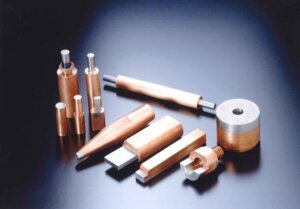Is shearing right for cutoff of simple shapes?
For simple cutoff of metal parts, the metal shearing process is a very tempting option. It’s fast. It’s easy. It’s cheap.
However, It’s important to understand the advantages and disadvantages of the metal shearing process — or any precision metal cutting method you might consider — so you can evaluate how it stacks up against your needs and priorities.
Good for Simple Shapes — But Not Always
Basically, shearing involves a moving blade applying pressure and pushing a workpiece up against a fixed blade. This metal shearing process (also commonly called die cutting or multi-slides) might be the ideal choice for quickly and inexpensively cutting simply shaped parts.
For instance, suppose you want to cut a simple hinge pin from solid 0.060” (1.5 mm) diameter low-carbon (i.e., non-stainless) steel wire. The metal shearing process can provide short parts from a continuous coil, giving you a lower per-part price than other methods. Since there is no risk of crushing while cutting wire, shearing will work just fine as long as some level of deformation is acceptable.
On the other hand, suppose you need extruded, thick wall tubes for plumbing, HVAC systems, and other pipes. Here, metal shearing tools could easily damage the extruded profile, making shearing a less than desirable option.
Advantages of Metal Shearing Process
Shearing performs straight-line cuts without forming chips or burning or melting the material. This allows the process to work well with most softer metals, such as aluminum, brass, bronze, and mild (low carbon) steel.
The metal shearing process can be used with virtually any diameter part and is especially cost-effective for high-output operations producing thousands of pieces per hour. In metal shearing machines, the blades can be mounted at an angle to reduce the amount of shearing force required to produce the cutoff.
Perhaps the biggest advantage of shearing is that it produces minimal or no kerf, with virtually no loss of material. For an application such as shearing a rod, the typical tolerance is ±0.005 (0.127 mm).
Notable Disadvantages of Shearing
Despite the “pros,” the metal shearing process also has some notable disadvantages.
Shearing is less than ideal with harder metals. For example, using the process for cutting tungsten is simply a bad idea. Because tungsten is extremely hard and often brittle, it can cause delamination or fracturing of the tungsten part, as well as significant wear on the tool itself.
Although the metal shearing process can be used with various diameters and is often cost-effective for high-volume operations, shearing is not ideal for lengths under 0.125” (3.175 mm).
In addition, metal shearing cannot be considered burr-free cutting. That is because the force of the shearing action itself often creates burrs and end deformation. As a result, shearing may not be the best choice for applications where a clean end finish is required.
The amount of deformation that occurs with the metal shearing doesn’t just depend on the force of the blades hitting the workpiece. It also depends on the clearance area, or the separation between the blades. The clearance is usually anywhere from 5% to 40% of the total thickness of the metal; again, that also varies with the kind of metal being sheared.
For larger diameters with large clearance, there may also be heavy burring if the parts twist or are not securely clamped in place during shearing.
For cutting of fine tubing, the shearing process doesn’t easily allow a mandrel to be put in place. This results in an unsupported cutoff that can cause the tube to be crushed. In some cases, a mandrel can be “floated” to support the tube ID. However, the method is imperfect and often results in imperfections in concentricity or end finish. This is especially true for small IDs, such as those required for capillary tubes.
How to Decide?
Deciding whether the metal shearing process is your best cutoff option requires an in-depth understanding of your unique application and its specific parameters. Making the best choice also requires an understanding of the different methods used for cutting metal.
How does the metal shearing process compare with other precision metal cutting methods? Keep reading to learn more.






